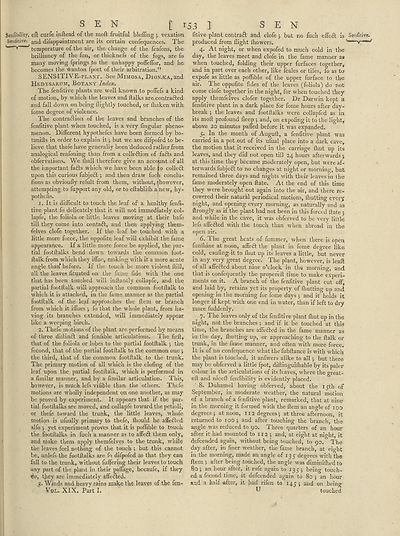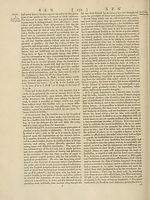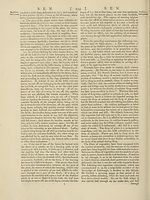Encyclopaedia Britannica, or, a Dictionary of arts, sciences, and miscellaneous literature : enlarged and improved. Illustrated with nearly six hundred engravings > Volume 19, Scripture-SUG
(163) Page 153
Download files
Complete book:
Individual page:
Thumbnail gallery: Grid view | List view

SEN [ i
Senfibillty, eft curfe inftead of the moft fruitful blefling • vexation
Senlitive. ancl difappointment are its certain confequences. The
temperature of the air, the change of the feafons, the
brilliancy of the fun, or thicknefs of the fogs, are fo
many moving fprings to the unhappy pofleflbr, and he
becomes the Canton fport of their arbitration.”
SENSITIVE-plant. See Mimosa, Dionvea, and
Hedysarum, Botany Index.
The fenfitive plants are well known to poflefs a kind
of motion, by which the leaves and rtalks are contra&ed
and fall down on being (lightly touched, or (haken with
fome degree of violence.
The contraction of the leaves and branches of the
fenfitive plant when touched, is a very lingular pheno¬
menon. Different hypothefes have been formed by bo-
tanifts in order to explain it •, but we are difpofed to be¬
lieve that thefehave generally been'deduced rather from
analogical reafoning than from a collection of fa£ts and
obfervations. We lhall therefore give an account of all
the important fafts which we have been able £0 colled
upon this curious fubjeCt ; and then draw fuch conclu-
(ions as obvioufly refult from them, without, ehowever,
attempting to fupport any old, or to cftablilh a new, hy-
pothefis.
1. It is difficult to touch the leaf of a healthy fenfi¬
tive plant fo delicately that it will not immediately col-
lapfe, the foliola or little leaves moving at their bafe
till they come into centaCt, and then applying them-
felves clofe together. If the leaf be touched with a
little more force, the oppofite leaf will exhibit the fame
appearance. If a little more force be applied, the par¬
tial footftalks bend down towards the common foot-
ftalk from which they iflue, making with it a more acute
angle than before. If the touch be more violent dill,
all the leaves fituated on the fame fide with the one
that has been touched will inftanlly collapfe, and the
partial footftalk will approach the common footftalk to
which it is attached, in the fame manner as the partial
footftalk of the leaf approaches the (tern or branch
from which it iffues ; fo that the whole plant, from ha¬
ving its branches extended, will immediately appear
like a weeping birch.
2. Thefe motions of the plant are performed by means
of three diftinCl and fenfible articulations. The firft,
that of the foliola or lobes to the partial footftalk •, the
fecond, that of the partial footftalk to the common one j
the third, that of the common footftalk to the trunk.
The primary motion of all which is the clofing of the
leaf upon the partial footftalk, which is performed in
a fimilar manner, and by a fimilar articulation. This,
however, is much lefs vifible than the others. Thefe
motions are wholly independent on one another, as may
be proved by experiment. It appears that if the par¬
tial footftalks are moved, and collapfe toward the petioli,
or thefe toward the trunk, the little leaves, whofe
motion is ufually primary to thefe, fhould be affefted
alfo •, yet experiment proves that it is poffible to touch
the footftalks in fuch a manner as to affeft them only,
and make them apply themfelves to the trunk, while
the leaves feel nothing of the touch ; but this cannot
be, unlefs the footftalks are fo difpofed as that they can
fall to the trunk, without fuffering their leaves to touch
any part of the plant in their paffage, bccaufe, if they
do, tjiey are immediately affe&ed.
2. Winds and heavy rains make the leaves of the fen-
Vol. XIX. Part I.
53 ] SEN
fitive plant contrail and clofe j but no fuch effect is Senfitive.
produced from flight (howers. w-—y—«
4. At night, or ivhen expofed to much cold in the
day, the leaves meet and clofe in the fame manner a»
when touched, folding their upper furfaces together^
and in part over each other, like (bales or tiles, fo as to
expofe as little as poffible of the upper furface to the
air. The oppofite fides of the leaves (foliola) do not
come clofe together in the night, for when touched they
apply themfelves clofer together. Dr Darwin kept a
fenfitive plant in a dark place for fome hours after day¬
break 5 the leaves and footftalks were collapfed as in
its moft profound deep 5 and, on expofing it to the light,
above 20 minutes paffed before it was expanded.
5. In the month of Auguft, a fenfitive plant was
carried in a pot out of its ufual place into a dark cave,
the motion that it received in the carriage (hut up its
leaves, and they did not open till 24 hours afterwards j
at this time they became moderately open, but rvere af¬
terwards fubjebl to no changes at night or morning, but
remained three days and nights Avith their leaves in the
fame moderately open date. At the end of this time
they Avere brought out again into the air, and there re¬
covered their natural periodical motions, (hutting every
night, and opening every morning, as naturally and as
ftrongly as if the plant had not been in this forced date j
and Avhile in the cave, it Avas obferved to be very little
lefs affe&ed Avith the touch than Avhen abroad in the
open air.
6. The great heats of fummer, Avhen there is open
funfliine at noon, affebf the plant in fome degree like
cold, caufing it to (hut up its leaves a little, but never
in any very great degree. The plant, however, is lead
of all affefted about nine o’clock in the morning, and
that is confequently the propereft time to make experi¬
ments on it. A branch of the fenfitive plant cut off,
and laid .by, retains yet its property of (hutting up and
opening in the morning for fome days ; and it holds it
longer if kept Avith one end in Avater, than if left to dry
more fuddenly.
_ 7. The leaves only of the fenfitive plant (hut up in the
night, not the branches 5 and if it be touched at this
time, the branches are affetled in the fame manner as
in the day, (hutting up, or approaching to the ftalk or
trunk, in the fame manner, and often Avith more force.
It is of no confequence Avbat the fubftance is Avith Avhich
the plant is touched, it anfwers alike to all ; but there
may be obferved a little fpot, diftinguiffiable by its paler
colour in the articulations of its leaves, Avhere the great-
eft and niceft fenfibility is evidently placed.
8. Duhamel having obferved, about the 15th of
September, in moderate Aveather, the natural motion
of a branch of a fenfitive plant, remarked, that at nine
in the morning it formed with the ftem an angle of 100
degrees ; at noon, 112 degrees; at three afternoon, it
returned to 100; and after touching the branch, the
angle Avas reduced to 90. Three quarters of an hour
after it had mounted to 11 2 ; and, at eight at night, it
defeended again, Avithout being touched, to 90. The
day after, in finer Aveather, the fame branch, at eight
in the morning, made an angle of 135 degrees Avith the
ftem ; after being touched, the angle Avas diminifhed to
80 ; an hour after, it rofe again to 135 ; being touch¬
ed a fecond time, it defeended again to 80 ; an hour
and a half after, it had rifen to 145 j and on being
^ touched
Senfibillty, eft curfe inftead of the moft fruitful blefling • vexation
Senlitive. ancl difappointment are its certain confequences. The
temperature of the air, the change of the feafons, the
brilliancy of the fun, or thicknefs of the fogs, are fo
many moving fprings to the unhappy pofleflbr, and he
becomes the Canton fport of their arbitration.”
SENSITIVE-plant. See Mimosa, Dionvea, and
Hedysarum, Botany Index.
The fenfitive plants are well known to poflefs a kind
of motion, by which the leaves and rtalks are contra&ed
and fall down on being (lightly touched, or (haken with
fome degree of violence.
The contraction of the leaves and branches of the
fenfitive plant when touched, is a very lingular pheno¬
menon. Different hypothefes have been formed by bo-
tanifts in order to explain it •, but we are difpofed to be¬
lieve that thefehave generally been'deduced rather from
analogical reafoning than from a collection of fa£ts and
obfervations. We lhall therefore give an account of all
the important fafts which we have been able £0 colled
upon this curious fubjeCt ; and then draw fuch conclu-
(ions as obvioufly refult from them, without, ehowever,
attempting to fupport any old, or to cftablilh a new, hy-
pothefis.
1. It is difficult to touch the leaf of a healthy fenfi¬
tive plant fo delicately that it will not immediately col-
lapfe, the foliola or little leaves moving at their bafe
till they come into centaCt, and then applying them-
felves clofe together. If the leaf be touched with a
little more force, the oppofite leaf will exhibit the fame
appearance. If a little more force be applied, the par¬
tial footftalks bend down towards the common foot-
ftalk from which they iflue, making with it a more acute
angle than before. If the touch be more violent dill,
all the leaves fituated on the fame fide with the one
that has been touched will inftanlly collapfe, and the
partial footftalk will approach the common footftalk to
which it is attached, in the fame manner as the partial
footftalk of the leaf approaches the (tern or branch
from which it iffues ; fo that the whole plant, from ha¬
ving its branches extended, will immediately appear
like a weeping birch.
2. Thefe motions of the plant are performed by means
of three diftinCl and fenfible articulations. The firft,
that of the foliola or lobes to the partial footftalk •, the
fecond, that of the partial footftalk to the common one j
the third, that of the common footftalk to the trunk.
The primary motion of all which is the clofing of the
leaf upon the partial footftalk, which is performed in
a fimilar manner, and by a fimilar articulation. This,
however, is much lefs vifible than the others. Thefe
motions are wholly independent on one another, as may
be proved by experiment. It appears that if the par¬
tial footftalks are moved, and collapfe toward the petioli,
or thefe toward the trunk, the little leaves, whofe
motion is ufually primary to thefe, fhould be affefted
alfo •, yet experiment proves that it is poffible to touch
the footftalks in fuch a manner as to affeft them only,
and make them apply themfelves to the trunk, while
the leaves feel nothing of the touch ; but this cannot
be, unlefs the footftalks are fo difpofed as that they can
fall to the trunk, without fuffering their leaves to touch
any part of the plant in their paffage, bccaufe, if they
do, tjiey are immediately affe&ed.
2. Winds and heavy rains make the leaves of the fen-
Vol. XIX. Part I.
53 ] SEN
fitive plant contrail and clofe j but no fuch effect is Senfitive.
produced from flight (howers. w-—y—«
4. At night, or ivhen expofed to much cold in the
day, the leaves meet and clofe in the fame manner a»
when touched, folding their upper furfaces together^
and in part over each other, like (bales or tiles, fo as to
expofe as little as poffible of the upper furface to the
air. The oppofite fides of the leaves (foliola) do not
come clofe together in the night, for when touched they
apply themfelves clofer together. Dr Darwin kept a
fenfitive plant in a dark place for fome hours after day¬
break 5 the leaves and footftalks were collapfed as in
its moft profound deep 5 and, on expofing it to the light,
above 20 minutes paffed before it was expanded.
5. In the month of Auguft, a fenfitive plant was
carried in a pot out of its ufual place into a dark cave,
the motion that it received in the carriage (hut up its
leaves, and they did not open till 24 hours afterwards j
at this time they became moderately open, but rvere af¬
terwards fubjebl to no changes at night or morning, but
remained three days and nights Avith their leaves in the
fame moderately open date. At the end of this time
they Avere brought out again into the air, and there re¬
covered their natural periodical motions, (hutting every
night, and opening every morning, as naturally and as
ftrongly as if the plant had not been in this forced date j
and Avhile in the cave, it Avas obferved to be very little
lefs affe&ed Avith the touch than Avhen abroad in the
open air.
6. The great heats of fummer, Avhen there is open
funfliine at noon, affebf the plant in fome degree like
cold, caufing it to (hut up its leaves a little, but never
in any very great degree. The plant, however, is lead
of all affefted about nine o’clock in the morning, and
that is confequently the propereft time to make experi¬
ments on it. A branch of the fenfitive plant cut off,
and laid .by, retains yet its property of (hutting up and
opening in the morning for fome days ; and it holds it
longer if kept Avith one end in Avater, than if left to dry
more fuddenly.
_ 7. The leaves only of the fenfitive plant (hut up in the
night, not the branches 5 and if it be touched at this
time, the branches are affetled in the fame manner as
in the day, (hutting up, or approaching to the ftalk or
trunk, in the fame manner, and often Avith more force.
It is of no confequence Avbat the fubftance is Avith Avhich
the plant is touched, it anfwers alike to all ; but there
may be obferved a little fpot, diftinguiffiable by its paler
colour in the articulations of its leaves, Avhere the great-
eft and niceft fenfibility is evidently placed.
8. Duhamel having obferved, about the 15th of
September, in moderate Aveather, the natural motion
of a branch of a fenfitive plant, remarked, that at nine
in the morning it formed with the ftem an angle of 100
degrees ; at noon, 112 degrees; at three afternoon, it
returned to 100; and after touching the branch, the
angle Avas reduced to 90. Three quarters of an hour
after it had mounted to 11 2 ; and, at eight at night, it
defeended again, Avithout being touched, to 90. The
day after, in finer Aveather, the fame branch, at eight
in the morning, made an angle of 135 degrees Avith the
ftem ; after being touched, the angle Avas diminifhed to
80 ; an hour after, it rofe again to 135 ; being touch¬
ed a fecond time, it defeended again to 80 ; an hour
and a half after, it had rifen to 145 j and on being
^ touched
Set display mode to:
![]() Universal Viewer |
Universal Viewer | ![]() Mirador |
Large image | Transcription
Mirador |
Large image | Transcription
Images and transcriptions on this page, including medium image downloads, may be used under the Creative Commons Attribution 4.0 International Licence unless otherwise stated. ![]()
| Permanent URL | https://digital.nls.uk/192697401 |
|---|
| Attribution and copyright: |
|
|---|
| Description | Ten editions of 'Encyclopaedia Britannica', issued from 1768-1903, in 231 volumes. Originally issued in 100 weekly parts (3 volumes) between 1768 and 1771 by publishers: Colin Macfarquhar and Andrew Bell (Edinburgh); editor: William Smellie: engraver: Andrew Bell. Expanded editions in the 19th century featured more volumes and contributions from leading experts in their fields. Managed and published in Edinburgh up to the 9th edition (25 volumes, from 1875-1889); the 10th edition (1902-1903) re-issued the 9th edition, with 11 supplementary volumes. |
|---|---|
| Additional NLS resources: |
|

